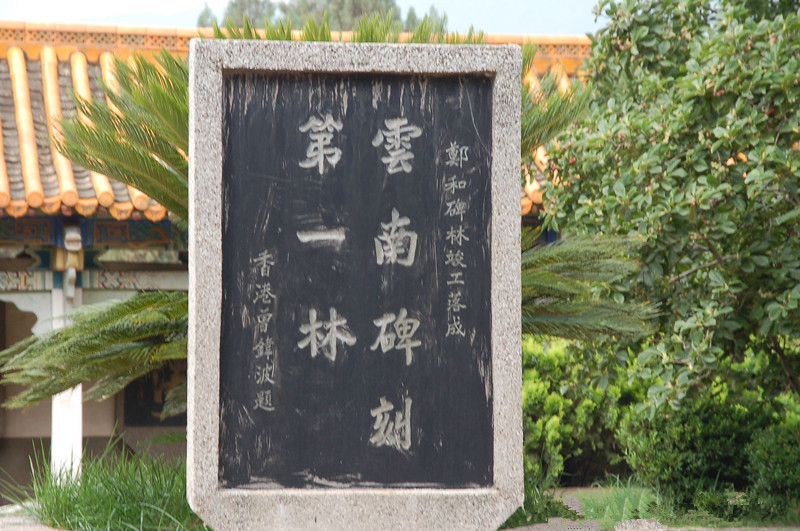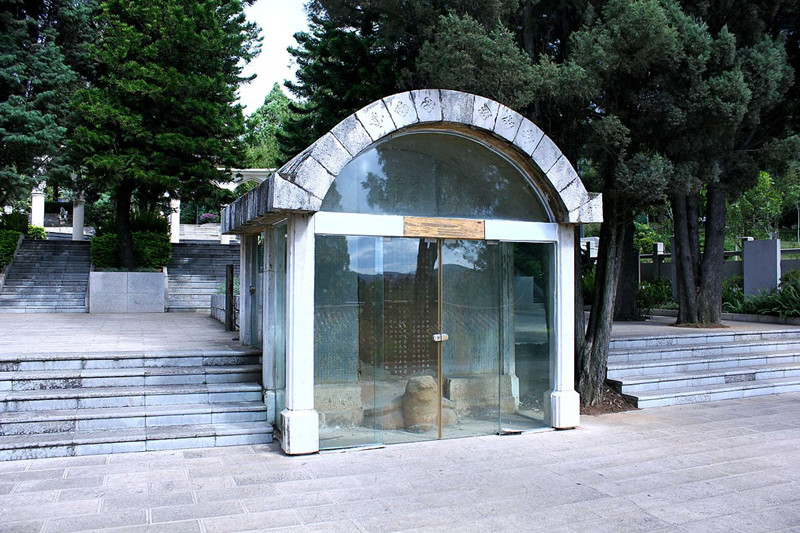Tomb of Ma Hazhi in Jinning District, Kunming
The Tomb of Ma Hazhi (马哈只墓碑) is located in Zheng He Park (郑和公园) in Kunyang Town (昆阳镇), Jinning District (晋宁县), Kunming (昆明), Yunnan Province (云南省), China. It is a historical site from the Ming Dynasty (明朝).
Overview of the Tomb
The Tomb of Ma Hazhi consists of four main parts:
- The first section features the national key cultural relic protection unit “Tombstone of Ma Hazhi” (马哈只墓碑) on the right side of the tombstone.
- The second section includes the inscription of Ma Hazhi’s tomb. Due to significant damage to the tombstone, the Jinning County government placed a glass protective cover around the Ma Hazhi tombstone to preserve it. Inside this glass cover, there are three engraved stones.
- The third section is the tomb of Ma Hazhi.
- The fourth section consists of four engraved stones.
The inscription on the tombstone, established on the Dragon Boat Festival (端阳日) in the third year of the Yongle era (永乐) in 1405, outlines the life and achievements of Ma Hazhi, father of Zheng He (郑和). It records his birthplace, personal character, and contributions, detailing his relationship to Kunyang and praising his virtue in serving the people. The discovery of the tomb clarified significant details regarding Zheng He’s origins and family background, making the tomb inscription an important historical document for researching Zheng He.
In May 2006, the Tomb of Ma Hazhi was officially listed as a national key cultural relic protection unit by the State Council of the People’s Republic of China.
Geographical Location
- Location: Zheng He Park (郑和公园) in Kunyang Town (昆阳镇), Jinning District (晋宁县), Kunming (昆明), Yunnan Province (云南省)
- Historical Period: Ming Dynasty (明朝)
- Protection Level: Listed as a national key cultural relic protection unit (第六批全国重点文物保护单位)
- Number: 6-863-4-053
- Approval Authority: State Council of the People’s Republic of China (中华人民共和国国务院)
Historical Background
The Tomb of Ma Hazhi was established on the Dragon Boat Festival (端阳日) in the third year of the Yongle era (永乐) in 1405. Zheng He returned to his hometown for ceremonial worship in the ninth year of Yongle (1411). During the Republic of China (民国) period, in the winter of 1924, the tomb was partially preserved with a memorial pavilion built by the descendants of the Mongolian prince from the Yuan Dynasty (元朝), Pu Huai Ya Lan Li Bo.
In 1935, Kunyang’s governor Yang Lisheng recognized the significance of the tombstone and funded the construction of a pavilion. He also erected two stones beside it: one inscribed with the tomb’s history and the other containing the biography of Zheng He from the “History of the Ming Dynasty” (明史). However, this pavilion suffered damage shortly thereafter. In 1944, local authorities rebuilt the pavilion, adding inscriptions by Mr. Yuan Jiagu and the “Tianfei Ling Ying Stele” (天妃灵应碑).
Renovations took place in 1958, with guardrails added in 1978, and further funding from the Yunnan Provincial Cultural Bureau for repairs in 1990. In 2005, to commemorate the 600th anniversary of Zheng He’s voyages to the West, the tombstone underwent another restoration.
Architectural Layout
The tomb of Ma Hazhi is located in Zheng He’s homeland, within Zheng He Park (郑和公园) in Jinning County (晋宁县), Yunnan Province (云南省). The entire tomb complex is divided into four sections:
- The first section includes the nationally recognized “Tombstone of Ma Hazhi” on the right side and a stone detailing the tomb’s overview on the left.
- The second section is the inscription of Ma Hazhi’s tomb. Due to severe damage, the Jinning County government placed a glass protective cover over the tombstone. Within the cover, there are three stones: the left stone contains the inscription by Xia Guangnan of Huize (会泽夏光南) on the tomb, while the right stone features the entry from “The History of the Ming Dynasty” about Zheng He.
- The third section contains the tomb itself. Islamic burial customs require earth burials, which align with the belief that the first man, Adam, was created from soil. Therefore, the Islamic tombs are typically rectangular with flat tops, contrasting with the circular mounds used by the Han Chinese. There are six engraved stones on either side of the tomb, commemorating various figures and events.
- The fourth section consists of four engraved stones, including a reproduction of the “Inscription of Ma Hazhi’s Tomb” and records of the tomb’s reconstruction.
Cultural Relics
The tomb features three preserved stones, with the central stone displaying the inscription “Inscription of the Tomb of Ma Hazhi” (故马公墓志铭) in seal script. The stone’s top is semi-circular, surrounded by decorative floral patterns, and rests on a large stone turtle. The inscription records the details of Zheng He’s visit in the ninth year of Yongle.
Full Text of the “Inscription of the Tomb of Ma Hazhi”
公字哈只,姓马氏,世为云南昆阳州人。祖拜颜,妣马氏。父哈只,母温氏。公生而魁岸奇伟,风裁凛凛可畏,不肯枉己附人,人有过,辄面斥无隐。性尤好善,遇贫困及鳏寡无依者,恒保护赒给,未尝有倦容。以故乡党靡不称公为长者。娶温氏,有妇德。子男二人,长文铭,次和;女四人。和自幼有材志,事今天子,赐姓郑,为内官监太监。公勤明敏,谦恭谨密,不避劳勋,缙绅咸称誉焉。呜呼,观其子而公之积累于平日,与义方之训可见矣。公生于甲申年十二月初九日,卒于洪武壬戌七月初三日,享年三十九岁。长子文铭奉柩安厝于宝山乡和代村之原,礼也。铭曰:身处乎边陲,而服礼义之习;分安乎民庶,而存惠泽之施,宜其余庆深长,而有子光显于当时也。时永乐三年端阳日,资善大夫礼部尚书兼左春坊大学士李至刚撰。
The “Inscription of the Tomb of Ma Hazhi” was buried during the wars of the Qing Dynasty (清朝) and was later discovered and published by Mr. Yuan Jiagu. The inscription chronicles the life of Zheng He’s father, Ma Hazhi, detailing his birthplace, character, and contributions.

Location:
















